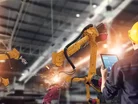Industry 4.0 and the rise of the ‘smart factory’

Smart factories are fast becoming mainstream in manufacturing, offering a new level of efficiency and productivity to those that invest in them. Industry 4.0, combined with increasingly sophisticated software and analytics, is playing a huge role in driving this movement.
Factories are no longer simply a mass of machinery operating as a series of siloed production lines. Instead, manufacturing executives and engineers manage interconnected networks of moving parts, something more akin to a living organism, that can be trained and fine-tuned to optimise performance.
New technologies such as big data, prognostics, machine learning and the cloud have changed the game when it comes to factory efficiency and maintenance. They are enabling manufacturers to proactively manage and improve the performance of these environments, with relatively low levels of investment.
The opportunities on offer from this new era of responsive, interconnected machinery are enormous. We are seeing higher levels of communication, transparency and yield. Engineers can now precisely predict and manage machine failures at the touch of a button. And through initiatives such as servitisation, the nature of relationships between equipment suppliers and manufacturers are being redefined before our eyes.
The accessibility of predictive maintenance
Our interest in Industry 4.0 is squarely in the area of condition monitoring and predictive maintenance. Although these are by no means new concepts, in the past they have been a reality for the few and a dream for the majority of manufacturers around the world. The cost and sheer complexity of gathering and analysing sufficient data to drive tangible results has limited the use of these proven tools largely to the defence and aerospace sectors.
The introduction of Industry 4.0, where production assets are connected and able to communicate through the Industrial Internet of Things (IIoT), combined with machine learning and advanced analytics from the likes of Senseye, has opened up the world of predictive maintenance to a much broader range of industries and use cases.
Previously, gathering the data required to inform conditioning monitoring activities was a laborious manual process requiring specialist expertise. The growing use of smart sensors and self-aware machines that record their own vital statistics and relay them for analysis over the IIoT, allows this vital data to be pulled from potentially thousands of machines at relatively low cost.
See also
- How technology is shaping a new era for the manufacturing workforce
- How technology is transforming manufacturing
- How technology can support behavioural safety in the manufacturing industry
Much like the gathering of machine data, the filtering and analysis required to translate it into actionable insight has also been an extensive manual endeavour that involved teams of data scientists. We are now seeing the emergence of intelligent machine learning algorithms that automate this activity too.
Smart algorithms crunch through all of the available data, comparing vital readings into machine vibration, pressure, temperature, torque and electrical current against known faults to spot emerging problems and identify if and when a machine will fail in the future.
This prognostic approach allows engineers to undertake precisely the right maintenance activities during periods of planned downtime and fix problems before they can affect production.
The benefits of predictive maintenance
Recent developments in condition monitoring and predictive maintenance, made possible through Industry 4.0, are significantly improving the performance of industrial machinery, and also making the task of operating and maintaining it easier and far more efficient.
Unplanned downtime is one of the biggest costs for any manufacturing environment. In the automotive sector, for instance, every minute that critical machinery carries a cost amounting to tens of thousands of pounds.
Being able to predict if and when a machine will fail in the future allows engineers to make repairs weeks or even months before a predicted failure might affect production. Senseye customers are typically able to halve their levels of machine downtime by using this automated approach, while also saving 40% on their maintenance costs too.
Although we are still in the early days of Industry 4.0, it is clear that enabling machines to gather data and connect with services like Senseye is already driving significant improvements in machine effectiveness and efficiency. The longer-term potential of Industry 4.0 has yet to be realised, but it is clear that its impact will be truly transformative

